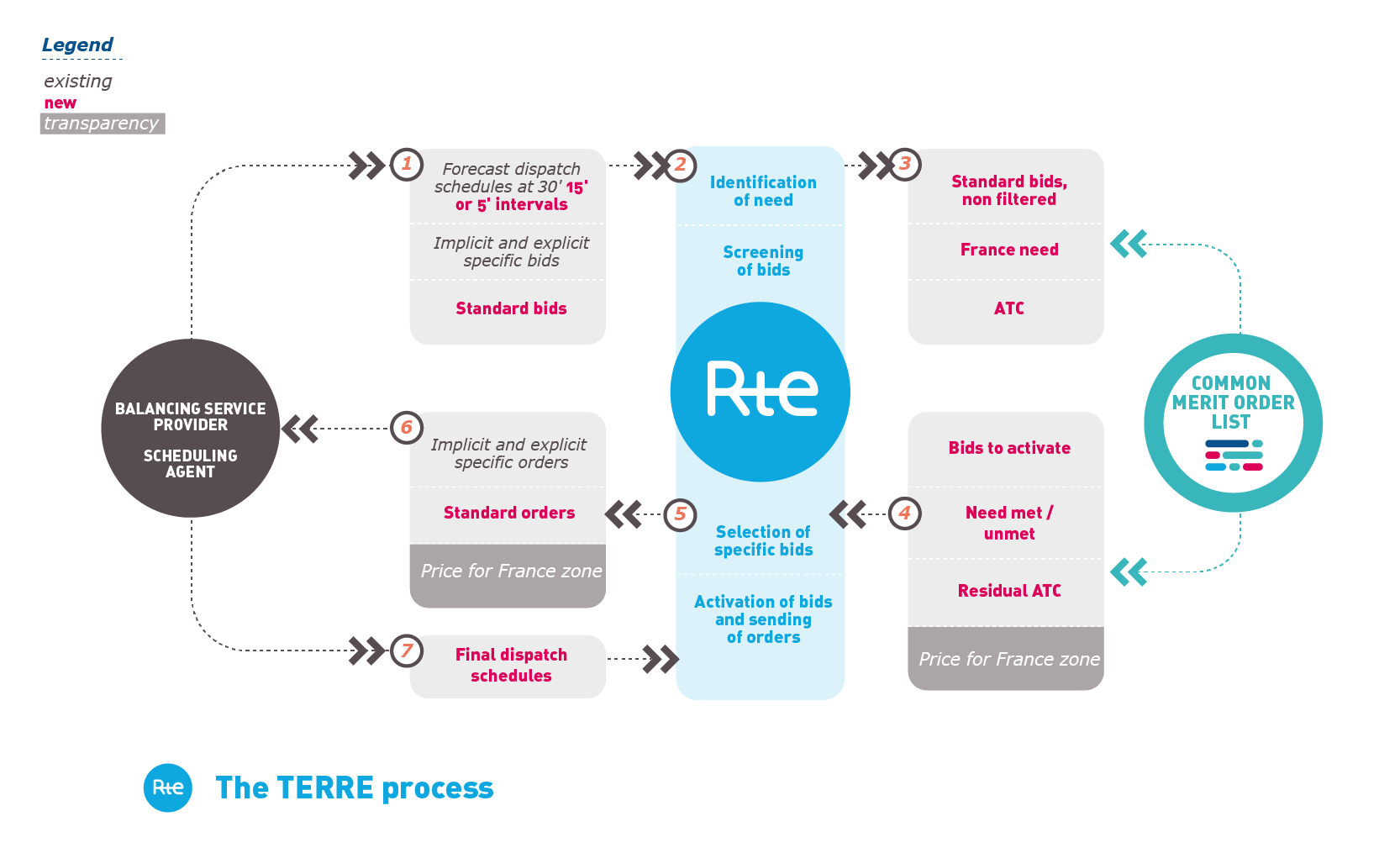Do you have an account?
Why create an account?
After creating an account you will :
- have access to the “favourites” feature,
- be able to download certain data published by RTE,
- have access to forms (PKI certificate, EIC code, Customer questionnaire - KYC),
- have access to notifications.
If you are an RTE customer, feel free to contact your administrator so that he or she can give you access to your company’s services.
A balancing bid can be activated for one of four reasons:
- Supply-demand balancing, known as P=C
- Reconstituting frequency ancillary services
- Reconstituting power margins
- Handling network congestion
Classifications and selections of specific bids
Specific balancing bids are selected for activation based on common merit order: bids meeting the balancing need at a given time are sorted respectively, ascending from the lowest price to the highest price and descending from the highest price to the lowest. Specific bids received by RTE are continuously ranked.
If two bids have an equal price and equivalent technical characteristics, there are priority rules:
-
A bid from a consumption BE takes priority over a bid from a generation BE.
-
A bid from a renewable energy source or a cogeneration facility has priority over a bid from another generation BE: this is known as priority dispatch.
In addition, in some cases, certain bids are ranked in a specific manner:
-
RTE may be required to categorise bids separately to meet specific needs, including the resolution of system congestion, the reconstitution of margins or frequency ancillary services, or the need to activate a bid in less than fifteen minutes (this includes BEs which participate in manual frequency restoration reserve or replacement reserve). These bids may therefore be out of merit order and may be retained to meet these needs where necessary.
-
For bids transmitted by exchange point BEs, RTE will likely not dispatch a bid arriving by merit order if there is not sufficient capacity available on the interconnection.
-
RTE may activate bids to carry out tests within the framework of provisions laid down in a capacity reservation contract or a regulatory provision, for example in the case of manual frequency restoration and replacement reserves. These activations for tests are out of merit order.
-
Bids from small "non-standardised” BEs are ranked together. They can only be dispatched if a more expensive bid has already been activated. When dispatched, they are automatically dispatched at their maximum power, without guaranteeing that all operating conditions are taken into account, and within the limit of 100 MW per half-hour interval.
Classification and selection of standard bids
Standard balancing bids are transmitted by RTE to the European TERRE platform according to a process defined between the partner TSOs and specifying the standard bids which are not technically activatable.
Standard balancing energy bids are made anonymous and transferred by RTE identically, i.e: without any changes to their content.
The PP=C balancing need is also transmitted by RTE to the TERRE platform. It corresponds to the total P=C balancing need provided by RTE on the hour H preceded by 40 minutes.
The selection of the standard bids to be activated is carried out by the TERRE platform according to a common merit order ranking process according to:
- the balancing needs of the various participating TSOs and
- the residual capacities available at interconnections with neighbouring countries.
For a time slot [H; H+1h[, RTE does not activate any specific bids for P=C balancing reasons before hour H preceded by sixty (60) minutes.
Balancing orders
A balancing order transmitted by RTE to receivers of orders contains:
- The power required
- Activation Time
- Deactivation Time It may be specified by RTE after the order is transmitted if the order is to be executed immediately.
For standard bids, balancing orders to be implemented on [H; H+1[ are transmitted 30 minutes before hour H.
RTE is also likely to send cancellation orders if a dispatched bid ultimately is not to be activated. The order is transmitted no later than the mobilisation lead time of the bid if it is not fixed by a technical agreement for generation BEs.
After receiving a balancing order on a BE, the scheduling agent must submit a final dispatch schedule corresponding to the entity’s schedule taking into account the balancing order. This final dispatch schedule then serves as a basis for settlement of the balancing operations. If it is not transmitted, it is established by RTE according to the balancing order.
Technical materials used
Balancing orders are transmitted via the TAO application. In case of unavailability, they are transmitted by telephone.
The final dispatch schedules are submitted by the participants on the TOPASE application.
The user guides of these applications are available here: Participating in the balancing mechanism.

Simultaneous activation of a standard and a specific bid and prioritisation of orders
In accordance with the bid usage conditions, RTE may simultaneously activate a standard bid and a specific bid on the same BE.
If several orders are submitted by RTE and it is not feasible to implement all of the orders due to a contradiction between the orders or due to the fact that implementing one of the orders makes it not possible to implement one or several others, the balancing service provider gives priority to the following orders, by order of highest to lowest importance:
- Immediate implementation orders for the system backup
- Bids submitted by telephone,
- Orders submitted using the TAO system and concerning specific bids,
- Orders submitted using the TAO system and concerning RR standard product bids.
This order of priority takes precedence over the order transmission time by RTE to the balancing service provider.
RTE is implementing a process to limit these situations. Traceability allows RTE, where relevant, to provide the balancing service provider with the reasons that led to these situations.
